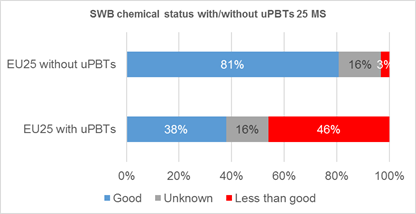Post a comment on the text below
3.2 Chemical status of surface waters
Reporting under the second RBMP shows that 38 % of surface water bodies are in good chemical status (by number of waterbodies), while 46 % are not achieving good status and the status of 16 % is unknown (Figure 3.1). While the percentage of water bodies in good status is more or less similar in rivers and in transitional and coastal waters at 40-58 %, that in territorial waters and lakes is considerably lower (15-24 %). The lower quality of lakes is driven by widespread contamination by mercury in Finland and Sweden.
Figure 3.1: Chemical status of surface water bodies, with and without and uPBTs

Note: For some surface water bodies in Poland (1265 WBs) and Italy (265 WBs), there is no information on the priority substances causing failure and it is therefore not possible to identify if the failure is caused by uPBTs or other priority substances.
Source: Preliminary results based on WISE-SoW database including data from 25 Member States (EU28 except Greece, Ireland and Lithuania).
The uPBTs are mercury, polybrominated diphenylethers (“BDEs”), tributyltin and certain[4] polycyclic aromatic hydrocarbons (PAHs). Widespread failure of mercury, and to a lesser extent BDEs (used as flame retardants), leads to significant failure to achieve good chemical status, as can be seen in Figure 3.2, where omission of the uPBTs shows 3 % of the surface water bodies as not being in good chemical status.
You cannot post comments to this consultation because you are not authenticated. Please log in.



Previous comments
"The uPBTs are mercury, polybrominated diphenylethers ("BDEs"), tributyltin and certain23 polycyclic aromatic hydrocarbons (PAHs). Widespread failure of mercury, and to a lesser extent BDEs (used as flame retardants), leads ..."
Please replace "BDE" by "PBDE"- also in the next sentence and the rest of the text (the abreviation BDE is used in the report at some pages)
In the legend of figure 3.1 ”less than good” should be replaced by ”failing to acheive good”.
"The uPBTs are mercury, polybrominated diphenylethers (“BDEs”) ... as can be seen in Figure 3.2..." shouldn't it be figure 3.1?
"The lower quality of lakes is driven by widespread contamination by mercury in Finland and Sweden."
This is "skewed" interpretation. Fish-Hg is just not regularly measured in other EU member states.
Suggested addition: However, the mercury concentration in fish is likely to exceed the EQS in other member states as well and the situation is not necessarily worse in Finland and Sweden than elsewhere in EU. The reason to these apparently unblanced percentages is that Finland and Sweden have more lakes than other member states and they have used Hg in fish in the classification.
Additional difference between the classification in these two countries comes from the fact that Finland has estimated background concentration for Hg in fish, whereas Sweden has not.
In fig 3.1 and 3.2 the chemical status of surface water bodies, SWB, with uBPTs is 46% chemical status is less than good while this is 50% in figure 3.4.
CZ: “The lower quality of lakes is driven by widespread contamination by mercury in Finland and Sweden”.
This is the same story as for 1st RBMP, clear effect of mercury being monitored in biota and assessed using EQS for biota contrary to the rest of MS monitoring mercury in water (mercury being hydrophobic and lipophilic). Please be careful with such statements or at least comment on it as done on page 36.
"Reporting under the second RBMP shows that 38 % of surface water bodies are in good chemical status (by number of waterbodies", whereas it seems it is 41% on page 56